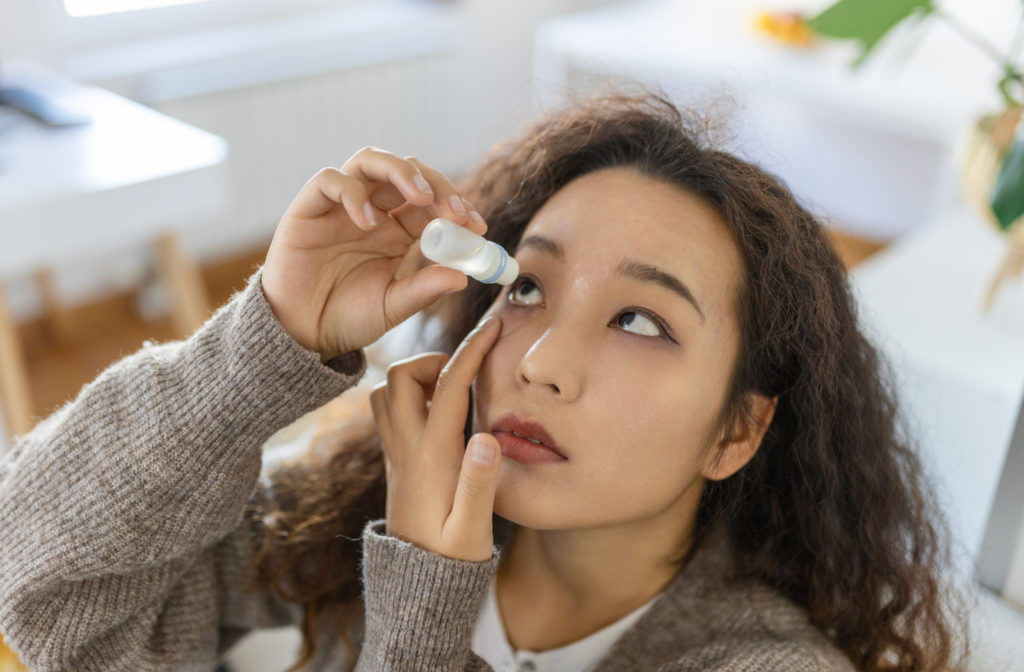Dry eye syndrome is a common condition. It causes burning, gritty, sandy, and dry sensations on the surface of your eye and can lead to long-term irritation and discomfort. Fortunately, it can be diagnosed and treated with the help of comprehensive eye exams.
Discomfort isn’t the only symptom of dry eyes. When dry eye disrupts your tear film, it can cause light to enter the eye incorrectly, leading to blurry vision and light sensitivity. Speaking with your optometrist to find treatment and relief from your dry eyes can also help you avoid dry eye complications like blurry vision.
What Is Dry Eye?
Dry eye is a condition that’s usually caused by a problem with your tear production. When your eye is functioning properly, it produces and spreads a thin film of tears every time you blink. That tear film creates a smooth surface over your eye that helps protect it, hydrate it, and flush away contaminants and dust.
Your tear film is covered by a thin layer of oils that is produced by your meibomian glands. These oils help protect the rest of the tear and keep it sealed, preventing it from evaporating too quickly. But when a problem develops with your meibomian glands, your tears can evaporate sooner than they should, causing the eye to begin drying out and resulting in dry eye syndrome.
Problems with tear production are often caused by:
- Aging and how it affects the eye
- Medical conditions, such as Sjogren’s syndrome and rheumatoid arthritis
- Complications from diabetes
- A particularly smokey, dusty, or dry environment
- Recent trauma, injury, or surgery on or around the eye
- Meibomian gland dysfunction
- Blepharitis and other eye conditions
These conditions often cause the eye to struggle with producing the necessary amount of quality tears, causing the eye to dry out and leading to several other symptoms.
What Symptoms Can Dry Eye Cause?
Once dry eye develops, it can cause other problems as well. The most common symptoms include a burning or gritty sensation on the eye, but can also include:
- Swelling or redness
- Strings of mucus around the edges of the eye
- Difficulty driving at night
- The feeling of something being stuck between the eyelid and eyeball
- Light sensitivity
- Irritation and discomfort
- Watery eyes
These symptoms can have a significant impact on your daily life, making it essential to visit your optometrist for dry eye treatment.
Does Dry Eye Cause Blurry Vision?
One of the biggest problems often caused by dry eye syndrome is how it can begin to affect your vision. In fact, almost 58% of people experiencing dry eye syndrome also notice their vision becomes blurry.
When your eye is healthy, it refracts light through the tear film and cornea to reach a singular focal point on the retina. The information received is sent through the optic nerve to the brain, where your brain can build a clear image of its environment.
When a problem develops with the tear film or cornea as a result of dry eye, these light rays don’t reach the right point. Instead, they bend or scatter as they enter the eye. This can lead to the brain receiving conflicting and messy information and can cause it to struggle to build a clear image.
Why Does Dry Eye Cause Vision Problems?
Dry eye can affect how light reaches the retina because of its effects on the surface of the eye. When dry eye begins to develop, the outside of the tear—which is usually clear, smooth, and uniformly curved—can become inconsistent in shape and stability. It could be evaporating too quickly or may have an irregular surface.
Changes in your tear film can cause light to scatter slightly before it reaches the retina and causes the brain to receive the wrong information, making your vision blurry. In some situations, this can even lead to eye strain and fatigue as your eyes need to work harder to properly do their job.
If dry eye is left untreated, it can leave the cornea vulnerable and unprotected. Over time, this can lead to damage to the surface of the eye, inflammation, and long-term vision issues. This makes it essential to visit your optometrist to discuss potential treatment for your dry eye.

Is Dry Eye Treatable?
Fortunately, dry eye syndrome is considered highly treatable. Typically, we’ll recommend one or more of the following:
- Eye drops or artificial tears
- Anti-inflammatory medication or topical steroids
- Tear duct plugs to stop tears from draining too quickly
- Compression masks to warm and soothe the inflamed area
If you wear contacts, your optometrist may recommend changing to specialty scleral lenses. Rather than sitting on the cornea, scleral lenses rest on the whites of your eyes and arch over the cornea to meet the other side of the eye. This can create a reservoir for your tears to rest on the cornea, stopping early evaporation and helping hydrate the eye.
Dry Eye Treatment in San Diego
At Total Vision Del Mar, we know how frustrating dry eye syndrome can be. With all the side effects it can cause and the irritation this condition creates, it’s essential to find treatment as soon as you can so you can get the relief you deserve.
Book an appointment with us today to speak with one of our experienced eye doctors!



